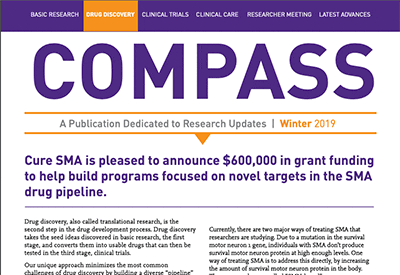Describing SMA
No two people with spinal muscular atrophy (SMA) have identical experiences. Decisions about care and treatment should be made according to each individual’s needs.
Quick Links
The History of Describing SMA
Historically, and prior to disease modifying treatment being available, SMA was characterized and divided into five types of SMA: Types 0, 1, 2, 3, and 4. This historical description by type of SMA is based on the age that symptoms began, and the highest physical milestone achieved. Within each type, abilities can vary from person to person. In addition, individuals with SMA frequently lost function over time due to loss of motor nerves and muscles continuing to weaken. This classification system describing age of onset and maximum motor function continues to apply to adults, teens, and some children with SMA. For additional information on the historical classification by Types of SMA, please see the information below.
How Do We Classify SMA Today?
Generally, we know that the number of SMN2 gene copies (the back-up gene for SMN1) a person has impacts the severity of SMA. Having more copies of SMN2 is associated with less severe symptoms of SMA. Following the approval of the first disease modifying treatment for SMA in 2016 (an SMN enhancing therapy) and the implementation of newborn screening for SMA in 2018, the historical classification of SMA does not adequately describe the new generation of infants and children with SMA treated early in life. In addition, more infants are being diagnosed and receive treatment prior to the onset of symptoms. With treatment, individuals are gaining more physical milestones and abilities than history would predict.
The SMA community of healthcare providers, people with SMA, and their families are having many conversations about how to best describe SMA disease in the era of disease modifying SMA treatment. Characteristics that have risen to the top and that are generally used together include:
- SMN2 copy number (SMN2 is an important disease modifying gene. Click here for more information)
- Maximum motor function achieved, for example non-sitter, sitter, and walker
- Age of symptom onset
- Impact of symptoms or the severity of symptoms
- Age at first treatment
Historical Classification of SMA Prior to Treatments:
Most Applicable To Older Children and Adults With SMA
Type 0
SMA Type 0 is very rare and very severe. Symptoms begin prior to birth and are seen as decreased fetal movement in the weeks prior to delivery. At birth, the infant has severe weakness and often difficulty breathing and feeding and may have joint contractures and heart problems. These infants typically require breathing and feeding support prior to confirming the diagnosis. These infants historically survived a few months.
Type 1
Also known as Werdnig-Hoffmann disease, SMA Type 1 is the most common (60%) and a severe form, usually diagnosed during an infant’s first six months. Babies with SMA Type 1 face many physical challenges, including muscle weakness and trouble breathing, coughing, and swallowing. Historically they often needed breathing assistance and a feeding tube. If not treated, Type 1 can be fatal early on in life.
Type 2
Type 2 is usually diagnosed after six months of age, but before two years of age. The first sign is often a delay in meeting motor milestones or failing to meet milestones entirely. Individuals with SMA Type 2 can typically sit up without help, though they may need assistance getting into a seated position. Historically, they are unable to walk and will require a wheelchair.
Type 3
Also called Kugelberg-Welander disease or juvenile SMA, Type 3 is usually diagnosed after 18 months of age and before three years of age. However, SMA Type 3 can be diagnosed as late as the teenage years. Individuals with SMA Type 3 are initially able to walk and historically have increasingly limited mobility as they grow, and eventually, many need to use a wheelchair.
Type 4
SMA Type 4 is very rare–less than 1% of all diagnosed cases. It usually surfaces in adulthood, and it leads to mild motor impairment. While symptoms can begin as early as age 18 years, they often begin after age 35 years.
Other Forms of SMA
Unlike the primary types of SMA described above, these other forms of SMA are caused by mutations in genes other than the SMN1 gene.
SMARD is a very rare form of SMA that affects the upper spinal cord more than the lower spinal cord. Babies with SMARD often experience severe respiratory distress due to diaphragm paralysis. They often have weakness in the hands, feet, and more distal muscles. SMARD is autosomal recessive and caused by specific mutations in the IGHMBP2 gene and can be diagnosed through genetic testing.
Distal SMA is another rare form of SMA and affects the motor neurons of the hands and feet. Symptoms usually begin with muscle cramping followed by weakness and muscle wasting. Distal SMA is associated with multiple gene mutations on different chromosomes. Distal SMA is inherited in an autosomal dominant pattern, which means that only faulty genes passed on from a parent with Distal SMA will cause the condition.
SMA-LED is a rarer form of SMA that begins in infancy or early childhood. SMA-LED affects the motor neurons of the lower extremities causing muscle weakness and wasting (atrophy) in the lower limbs. It most severely affects the thigh muscles (quadriceps), resulting in unsteady walking, difficulty climbing stairs, and getting up from sitting. The inheritance is autosomal dominant, which means that only one faulty gene copy is needed from an affected parent to cause the condition. SMA-LED has been linked to mutations in two different genes: DYNC1H1, a gene located on chromosome 14; and BICD2, a gene located on chromosome 9.
Another rare form of SMA, Kennedy’s disease, is an X-linked genetic disease, meaning it only affects males. It usually appears between the ages of 30 and 50. It causes muscle weakness and atrophy throughout the body, which is most noticeable in the legs and arms. It is also especially noticeable in the face and throat and causes speech and swallowing difficulties and also muscle cramps.
X-Linked SMA is a very rare form of SMA that appears in infancy. This form causes severe muscle weakness and difficulty breathing, and infants may be born with broken bones. Inheritance is X-linked and affects predominantly males.



